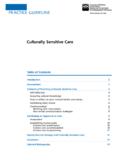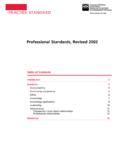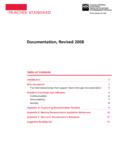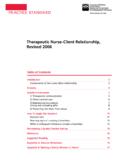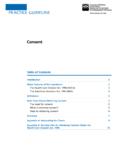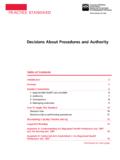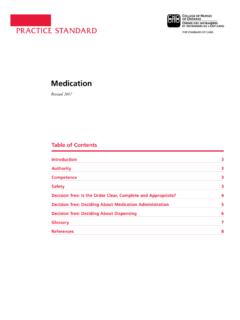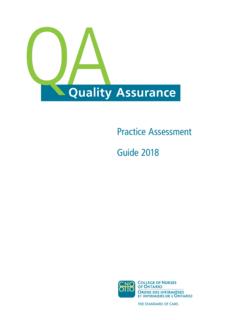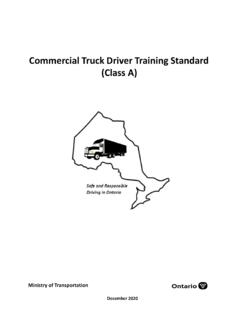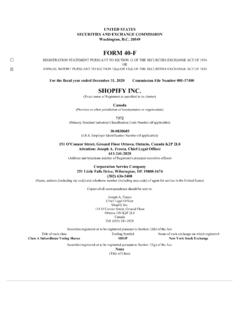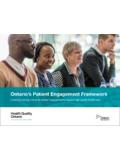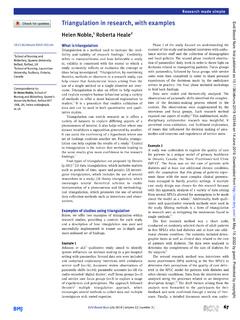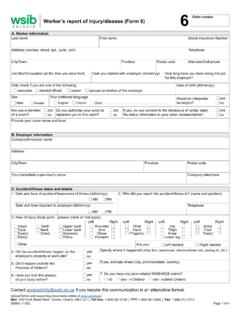Transcription of PRACTICE STANDARD Decisions About Procedures and ... - CNO
1 PRACTICE STANDARDT able of Contents Introduction 3 Glossary 4 STANDARD Statements 61. Appropriate health care provider 62. Authority 73. Competence 84. Managing outcomes 9 How To Apply This STANDARD 10 Decision tree 10 Decisions About performing Procedures 11 Maintaining a Quality PRACTICE Setting 12 Suggested Reading 13 Appendix A: Understanding the Regulated Health Professions Act, 1991 and the Nursing Act, 1991 14 Appendix B: Controlled Acts Established in the Regulated Health Professions Act, 1991 16 Continued on next pageDecisions About Procedures and AuthorityTable of Contents continuedDecisions About Procedures and Authority Pub.
2 No. 41071 ISBN 978 -1-77116 -108 - 4 Copyright College of Nurses of ontario , or for-profit redistribution of this document in part or in whole is prohibited except with the written consent of CNO. This document may be reproduced in part or in whole for personal or educational use without permission, provided that: Due diligence is exercised in ensuring the accuracy of the materials reproduced; CNO is identified as the source; and The reproduction is not represented as an official version of the materials reproduced, nor as having been made in affiliation with, or with the endorsement of, published July 1995 as A Guide to Decide: Revised Decision Tree for Performance of Procedures Reprinted January 2000 as A Guide to Decide: A Decision Tree for Performance of Procedures Reprinted October 2000, December 2002, Revised for Web June 2003, Reprinted January 2004, December 2005. Revised October 2006. Reprinted May 2008. Updated June 2009 (ISBN 1-897308-14-0). Updated November 2011 for Bill 179 changes.
3 Revised 2013 for Delegation Regulation. Revised 2014 for Dispensing (ISBN 978-1-77116-021-6). Updated dated February 2017, removed emergency procedure pg17 (ISBN 978-1-77116-054-4). Revised January & March 2018 for Controlled Act of Psychotherapy. (ISBN 978-1-77116-096-4) Additional copies of this document may be obtained by contacting CNO s Customer Service Centre at 416 928-0900 or toll-free in Canada at 1 800 of Nurses of ontario 101 Davenport Rd. Toronto, ON M5R fascicule existe en fran ais sous le titre : La prise de d cisions sur les interventions, no 51071 VISION Leading in regulatory excellenceMISSION Regulating nursing in the public interestAppendix C: Exceptions to the Need for Authorization 17 Appendix D: Initiation of Controlled Acts 18 PRACTICE STANDARD3 College of Nurses of ontario PRACTICE STANDARD : Decisions About Procedures and AuthorityNursing standards are expectations that contribute to public protection. They inform nurses of their accountabilities and the public of what to expect of nurses.
4 Standards apply to all nurses regardless of their role, job description or area of PRACTICE . College of Nurses of OntarioIntroductionAs knowledge and technology advance and health care environments change, nursing PRACTICE evolves. Increasingly, nurses1 face Decisions About performing Procedures that are new, or were previously the responsibility of other professionals. This PRACTICE document outlines the expectations of nurses when determining if: they have the authority to perform a procedure;2 it is appropriate for them to perform a particular procedure; and they are competent to perform the procedure. This document allows for flexibility in nursing roles while protecting the public interest. It facilitates timely, efficient access to health care and fosters effective interprofessional collaboration, while ensuring that appropriate measures are in place to promote safe, effective and ethical client3 care. Nurses may consider accepting delegation4,5 of any controlled act procedure not authorized to nursing as long as they comply with requirements in regulation.
5 Nurses must adhere to this PRACTICE STANDARD when performing any procedure related to nursing PRACTICE . This includes Procedures authorized to nurses in the Nursing Act, 1991, those delegated, those carried out in emergencies and those that do not fall within a controlled College of Nurses of ontario (the College) publishes PRACTICE standards to: outline the generally accepted expectations of nurses and set out the professional basis of nursing PRACTICE ; provide a guide to the knowledge, skill, judgment and attitudes that are required to practise safely; describe what each nurse is accountable for in PRACTICE ; and achieve public protection when adhered PRACTICE documents apply to all nurses regardless of their roles or areas of PRACTICE . This PRACTICE document helps nurses, nursing administrators and employers to make appropriate Decisions About nurses performing Procedures , including Procedures that require additional authority ( , delegation). If standards are breached, it could be professional Decisions About Procedures and authority is a complex issue that can have serious ramifications.
6 This document has organized the factors that a nurse has to consider when making a decision About performing a are four STANDARD statements with indicators that describe a nurse s accountabilities when performing any procedure. Use the Decision Tree on page 10 and the Decisions About Performing Procedures chart on page 11 to work through a procedure relevant to your individual A contains an overview of the relevant legislation concerning authorization and the performance of Procedures , the Regulated Health Professions Act, 1991 (RHPA) and the Nursing Act, 1991. These acts acknowledge the overlapping scopes of PRACTICE among regulated health professionals. They also provide a flexible framework for changes in PRACTICE to accommodate advances in technology and health In this document, nurse refers to a Registered Practical Nurse (RPN), Registered Nurse (RN) and Nurse Practitioner (NP).2 The word procedure, for the purpose of this document, includes controlled acts and non-controlled act Procedures , as well as actions, activities and/or measures that nurses use in the course of providing client In this document, client may be an individual, family, group or See ontario Regulation 275/94 under the Nursing Act, 1991, and Authorizing Mechanisms at 5 Bolded words are defined in the glossary, which begins on page STANDARD4 College of Nurses of ontario PRACTICE STANDARD : Decisions About Procedures and AuthorityGlossaryThis section defines terminology that is used throughout this PRACTICE STANDARD .
7 Many of these words have specific meanings in legislation, and their meanings can differ from the general understanding of the words in everyday mechanism. An authorizing mechanism is a means by which the authority to perform a procedure is obtained or the decision is made to perform a procedure. The appropriate authorizing mechanism depends on the nurse s category or class, role and PRACTICE setting. Examples of authorizing mechanisms include orders, initiation, directives and delegation. Delegation and orders are distinct authorizing mechanisms, but a delegation may include an order. For example, an RN or RPN obtains the authority to adjust cardiac pacemakers through a formal delegation process. The RN or RPN also needs to know the parameters to adjust the cardiac pacemaker for a particular client. The delegation could include criteria describing when it is appropriate to perform the controlled act. (This would replace the need for client-specific orders.) Alternatively, an order for a particular client could provide this information.
8 See the Authorizing Mechanisms PRACTICE document for more Delegation is a formal process that transfers the authority to perform a controlled act. A regulated health professional who has the legislated authority and competence to perform a procedure within one of the controlled acts can delegate that procedure to others. See the Authorizing Mechanisms PRACTICE document for the requirements for nurses who delegate or accept delegation. Direct client order. A client-specific order can be an order for a procedure, treatment, drug or intervention for an individual client. An individual practitioner ( , physician, midwife, dentist, chiropodist or NP) directs a specific intervention to be performed at a specific time(s) for a specific client. A direct order may be written or oral; for example, given by telephone. Preprinted orders are supportive tools that require a client s name, the date and an authorizing signature before A directive is an order for a procedure, treatment, drug or intervention that may be implemented for a number of clients when specific conditions are met and specific circumstances exist.
9 Most often a directive is a physician s order, and it is always written. For more information, refer to the College s PRACTICE guideline Regulations under the Nursing Act give RNs and RPNs who meet certain conditions the authority to initiate specific controlled acts. These nurses may independently decide that a specified procedure is required and initiate that procedure in the absence of a direct order or directive. The conditions are outlined in Appendix RNs and RPNs have the authority to initiate, the opportunity may be limited in PRACTICE by legislation, role or PRACTICE -setting policy. For example, the Public Hospitals Act, regulation 965 requires an order from an identified practitioner, such as an NP or a physician, for patient treatments and diagnostic Procedures . Order. An order is a prescription for a procedure, treatment, drug or intervention. The RHPA, Nursing Act and other legislation, such as the Public Hospitals Act, identify the health care providers who can provide orders for client care.
10 The order is the decision to perform the procedure for a particular client or group of clients. Orders are required when: a procedure falls within one of the controlled acts authorized to nursing when the nurse does not have the authority to independently decide to perform ( , initiate) the procedure; required under the Public Hospitals Act, Healing Arts Radiation Protection Act or other legislation governing client services; and required by a PRACTICE -setting policy or as agreed on within the physician s plan of STANDARD5 College of Nurses of ontario PRACTICE STANDARD : Decisions About Procedures and AuthorityProfessional misconduct. The Nursing Act includes regulations that identify professional misconduct. Some of the professional misconduct regulations relevant to a nurse s decision to accept delegation and perform Procedures include the Contravening a STANDARD of PRACTICE of the profession or failing to meet the STANDARD of PRACTICE of the Directing a member, student or other health care team member to perform nursing functions for which she or he is not adequately trained or competent to Failing to inform the member s employer of her or his inability to accept specific responsibility in areas in which specific training is required or for which the member is not competent to function without Contravening a provision of the Nursing Act, the Regulated Health Professions Act, 1991 or regulations under either of those STANDARD6 College of Nurses of ontario PRACTICE STANDARD .

